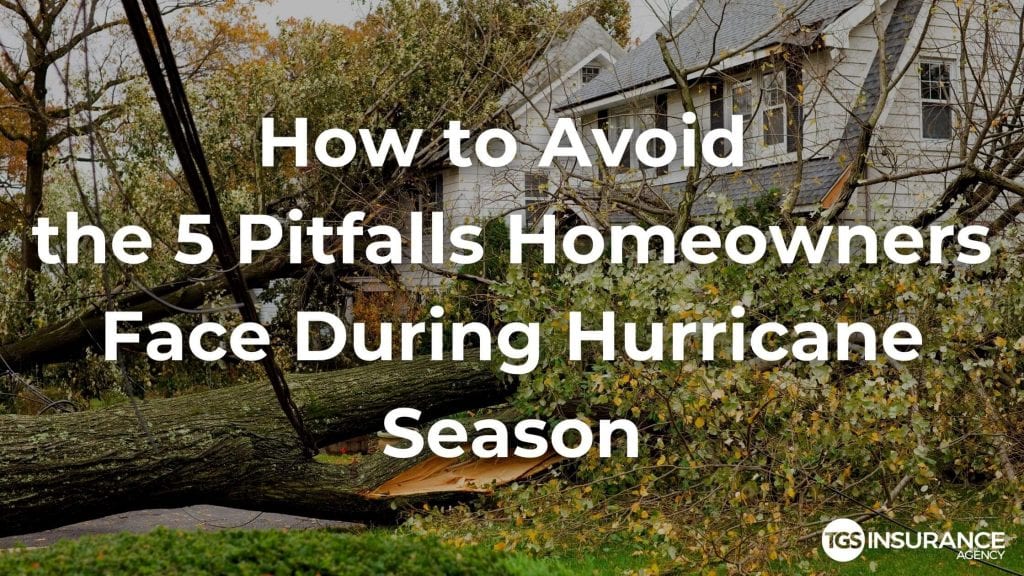
Hurricane season isn’t the time of the year for homeowners to neglect caring for their homes. It can be easy for homeowners to believe “it won’t happen to me,” but as we continue to see, flood and wind damage can happen to anyone, especially to homes near the Gulf Coast. In 2020, we saw a historic rate of storms that brought devastating winds, rain, and storm surges to a variety of states, including Texas. For 2023, the weather predictions for this hurricane season may not be at the levels of last year, but they are still above the 30-year average.
Staying prepared is a must this hurricane season! When you combine the uptick of natural disasters, ranging from hurricanes to wildfires throughout the country, with an increase in the cost of repairing a home, leads to the price of insurance also increasing. Making sure you are properly prepared to protect your home and finances is paramount. Let’s review five pitfalls homeowners may fall into during hurricane season and how you can rectify these issues to stay protected all hurricane season and beyond.
1. Not Having a Plan for Hurricanes
Having a plan for hurricane season is step one. Your home should have the proper procedures in place to handle evacuations when necessary or bunkering down when it’s safe to do so. This includes having a plan for protecting your possessions, securing your home, safely traveling, communicating, and protecting your finances. Home insurance is a great tool to protect your home; however, while it will protect your home from many perils, it is not blanket coverage. Hurricane insurance, a combination of flood insurance and windstorm insurance, can help you stay prepared against wind damage, rains that cause flooding, and storm surges.
2. Failing to Review Your Insurance Coverage
Many homeowners are wise enough to have insurance coverage, but they may fail to review their coverage options. For example, if you have home insurance and flood insurance but windstorm is not covered, then you could be left having to restore losses caused by wind on your own. Furthermore, you may have the right insurance policies in place but you could be overpaying as rates tend to rise as time goes on. A TGS Insurance agent is a trained professional capable of helping homeowners review their coverage options and find the right coverage for their needs all while saving homeowners money along the way.
3. Having An Inadequate Amount of Insurance
Because of the rise we see in repairing homes and the rise in home values, inadequate coverage can be a problem. Homeowners should also consider the method in which their policies pay after a loss because these methods can make or break how you recover after a storm. Replacement cost does not consider depreciation and will pay to replace what is lost with a comparable model. Actual cash value does take depreciation into account and will pay less after a loss. Remember to review your insurance coverages and ensure that you are capable of restoring your losses and avoid being underinsured.
4. Insufficient Funds for Paying Your Deductible
Your deductible is the amount you must pay before your insurance provider will step in and cover the rest to help you restore your loss. Homeowners that have lower deductibles will face higher premiums and vice versa, but it is still your responsibility to cover these costs to receive compensation no matter which type of deductible you choose. As homes go longer and longer without experiencing a loss from a hurricane, it can be normal for households to budget less and less. Always prepare for the worst while hoping for the best. You’ll need to save an adequate amount in the unfortunate event your home is affected.
5. Getting Insurance Too Late
It can be tempting to wait until the last minute to enroll in flood insurance or windstorm insurance. Many homeowners may feel that they are not necessary at the time, however, hurricane season begins on June 1st and lasts until November 30th. Windstorm coverage will not be written to homes while a named storm is in the Gulf of Mexico. Flood insurance can take 30 days to go into effect as well. This means that waiting for the last second will leave you with a major gap in coverage all while paying more due to rising rates.
There can also be opportunities for homeowners to increase their coverage before a storm hits that can help them save on their premium. Here at TGS Insurance, we help homeowners find the right homeowners insurance, flood insurance, and windstorm insurance coverage for their needs that will protect their homes without breaking the bank. We even automatically include windstorm coverage with a 2% deductible because we want you to be as prepared as possible when protecting your home.
We save customers throughout Texas every day, by comparison shopping their flood, wind, and home insurance policies among our impressive bank of over 35 top-rated insurance providers, including both private and government-backed insurance plans. See how much you can save and avoid these pitfalls to stay protected during hurricane season and all year long!